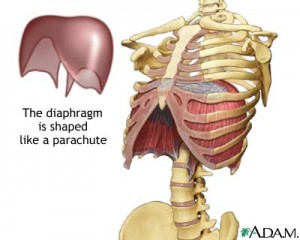Prior to learning how to sing, you should first learn breathing exercises for singing to control your breathing so that when you do sing, you perform at your optimal level.
All humans are born with the natural ability to breathe. Unfortunately, as people grow older, they get lazy with their breathing habits. People develop the habit of taking shallow breaths, which improperly uses only the upper part of the lungs. This impedes the natural use of your full lung space.
Anatomy of Breathing
Before you learn breathing exercises for singing and how to properly maximize vocal effectiveness, it is helpful to first understand the basic anatomy of the human respiratory system.
 Your lungs are surrounded by a muscle structure called the diaphragm. The diaphragm is connected to your ribs and acts as an inflation apparatus. Highly effective singers learn to manipulate their diaphragm system and control the rate and volume of air that is exhaled. This in turn affects the quality of a singer’s voice.
Your lungs are surrounded by a muscle structure called the diaphragm. The diaphragm is connected to your ribs and acts as an inflation apparatus. Highly effective singers learn to manipulate their diaphragm system and control the rate and volume of air that is exhaled. This in turn affects the quality of a singer’s voice.
To understand how the diaphragm works in practice, try holding your hand in front of your face and breathing on it slowly. Pay special attention to your diaphragm as you breathe outwards. As you breathe out, feel you stomach move inwards as air is exhaled. Allow your stomach’s inward movement to flow naturally; you don’t want to “suck in” your stomach. Allow the diaphragm to steadily deflate at its own natural pace until you reach the end of your breath. This contracting motion is the correct breathing method to use when you are singing. Singers should not force excess air through their vocal chords in an attempt to produce a stronger sound. Pushing the diaphragm can place excess pressure against your vocal chords and this can cause damage to the voice.
Singing is accomplished when a person expands the lungs by breathing in and “controlling” the amount of air exhaled, while singing a note. When a singer breathes in, you can imagine the diaphragm as the muscular support for the lungs as your lungs expand like a balloon. When you sing, you are simply slowing down the exit rate of air as your lungs deflate and air is exhaled. Most adults adopt shallow breathing habits and actively use only the top half of their lungs during normal respiration. However, the best way to breathe – and the correct breathing method you should use for singing – is to use the entire lung, filling the balloon in its entirety. This way singers have more air available, and you also take advantage of an extra set of refined muscles (the diaphragm and abdomen) to assist in the control of air exhalation and singing notes.
Breathing Exercises for Singing
Practice the exercise outlined below to improve your breathing control for singing. The exercise might feel exhaustive at first, but try to incorporate this into your daily routine. You will find that over time, your body will need less effort to breath, and you will have greater control over your diaphragm and abdominal muscles when singing.
- Lay down flat on your back.
- Place both hands on your stomach with your fingers pointing towards your belly button.
- Take a deep breath and concentrate on filling your stomach with air. You should not be filling yourself with air to the point of bursting, but make sure you inhale deeply enough that there is a noticeable difference between a deep and shallow breath.
- Feel your stomach expand and notice how your hands gently rise up and outwards as your chest also expands. This inhalation process occurs not only at the front of the body but also on the sides and back of your body as well.
- Exhale slowly for five seconds.
- Repeat this exercise 10x
Integrate these breathing exercises for singing into your daily routine. Practice this every morning in bed after you wake up, and practice once more before you go to sleep. The breathing exercise for singing only takes 5 to 10 minutes a day. Once you feel comfortable practicing this routine, you can gradually increase this workout to 3 or 4 times a day.
Once you master this technique, you can start to practice as often as possible. Perform breathing exercises while sitting, standing, or even while you’re doing everyday tasks. Practice until breathing from your abdomen becomes a natural habit.
You can also try exercises to improve your breathing control.
- While exhaling on a single breath, try singing numbers.
- Start with the number 1, singing each number in a clear, strong voice
- Sing out the numbers in sequential order, and see how far you can get.
- Continue to practice this breathing control exercise for singing until you can reach the number 25 without straining or running out of breath.
No related Articles.

